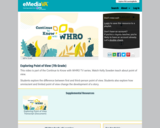
This video is part of the Continue to Know with WHRO TV series. Watch Kelly Sowden teach about point of view.
- Subject:
- English
- Reading
- Material Type:
- Lesson
- Visual Media
- Provider:
- WHRO Education
- Author:
- WHRO Education
- Date Added:
- 10/07/2020

This video is part of the Continue to Know with WHRO TV series. Watch Kelly Sowden teach about point of view.
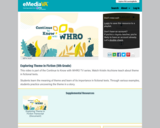
This video is part of the Continue to Know with WHRO TV series. Watch Kristin Acchione teach about theme in fictional texts.
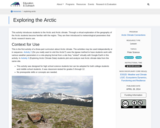
This activity introduces students to the Arctic and Arctic climate. Through a virtual exploration of the geography of the Arctic students become familiar with the region. They are then introduced to meteorological parameters that Arctic research teams use.

This is an activity about the solar activity cycle. Learners will construct a graph to identify a pattern of the number of observed sunspots and the number of coronal mass ejections emitted by the Sun over a fifteen year time span. A graphing calculator is recommended, but not required, for this activity. This is the second activity in the Solar Storms and You: Exploring the Wind from the Sun educator guide.

This lesson is part of the Virginia K-12 Computer Science Pipeline which is partly funded through a GO Virginia grant in partnership with Chesapeake Public Schools, Loudoun County Public Schools, and the Loudoun Education Foundation. In this lesson, students take on the role of a reporter traveling with Lewis and Clark. Students program an Ozobot to travel along the path and pause at key sites as students report inportant findings and share artifacts from the expedition.

This video is part of the Learn and Grow with WHRO TV series. Watch Patty Larson teach about extending patterns that repeat.

Teachers will be able to use this lesson virtually or in person! This Google Slide deck lesson can also be downloaded as a PowerPoint! Speaker notes are included which make it easy for teachers or substitutes to teach this lesson! Read Aloud: Extremely Cute Animals Operating Heavy Machinery *Literacy Objectives: 3.2d) Organize ideas sequentially or around major points of information using appropriate facts and relevant details *3.5 h) Draw conclusions using the text for support. i) Identify the conflict and resolution *Science: VA SOL 3.2: Simple machines and how they help us change the direction or size of a force. *Social Studies: VA SOL 3.1f: Relationships with multiple causes & effects. 3.1g: Making connections across time & place. 3.2: explain how the contributions of ancient Egypt have influenced the present world in terms of architecture, inventions, the calendar, and written language. Hampton Oaks Elementary School (Kari Nugent, Annie Schmidt, Lindsey Bruce, Melissa DiAscro, & Rebecca Fausett)

Literacy Objective: Students will be able to identify the conflict and solution in a story. Science Objective: Students will identify simple machines. Art Objective: Students will learn about the primary, secondary, intermediate, and warm and cool colors.
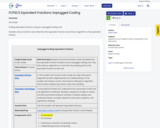
4th GradeFinding equivalent fractions using an unplugged coding mat. Students draw a fraction card, determine the equivalent fraction and write an algorithm to the equivalent fraction.
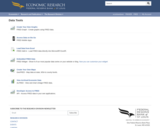
Use FRED data to create custom maps, charts, to access data "on the go" through mobile apps, or use FRED data to develop mobile app.

Engage students in a discussion about the definition of failure and why so many people are afraid of it using Theodore Roosevelt's Man in the Arena speech from 1910.
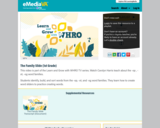
This video is part of the Learn and Grow with WHRO TV series. Watch Carolyn Harris teach about the -op , -ot, -og word families.

Students will understand the personal information of each famous American, why it is important, and how their personal information is important.

Teach about the Fibonacci sequence being a series of numbers and which is found reflected in nature. Students create artwork based on the sequence.
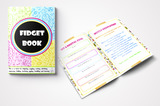
This fidget book was designed to be used in digital citizenship and internet safety lessons for elementary students. It has lesson supports, coloring pages, self-reflection guides and more.

The nine tick and tick-borne disease prevention activities in this package align with the Virginia Standards of Learning for Health and Physical Education for 3rd to 5th grade. Topics include, but are not limited to: how to identify a tick, proper tick-borne disease prevention techniques, and safe tick removal. These active learning activities are presented in a lesson plan-type format and can be used alone or in combination to easily create lessons or a unit. They can be easily modified for use with older school-age students and adult populations.These educational resources were developed by a Health and Physical Educator and a Master Certified Health Education Specialist in support of Virginia House Bill 850. The bill requires the development of school-age-appropriate educational resources for schools and public libraries by 2028 to protect children from Lyme disease and other tick-borne diseases.

This lesson introduces the difference between literal and figurative language and then gives an overview on similes, metaphors, idioms, hyperbole, onomatopoeia and alliteration. The attached PowerPoint explains each of the figurative language with an example

This video is part of the Continue to Know with WHRO TV series. Watch Kelly Sowden teach about figurative language.
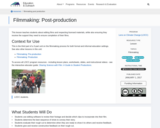
This lesson teaches students about editing films and respecting licensed materials, while also ensuring they receive the support they need to ensure completion of their films.
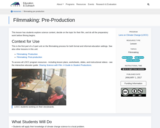
This lesson has students explore science content, decide on the topic for their film, and do all the preparatory work before filming begins.